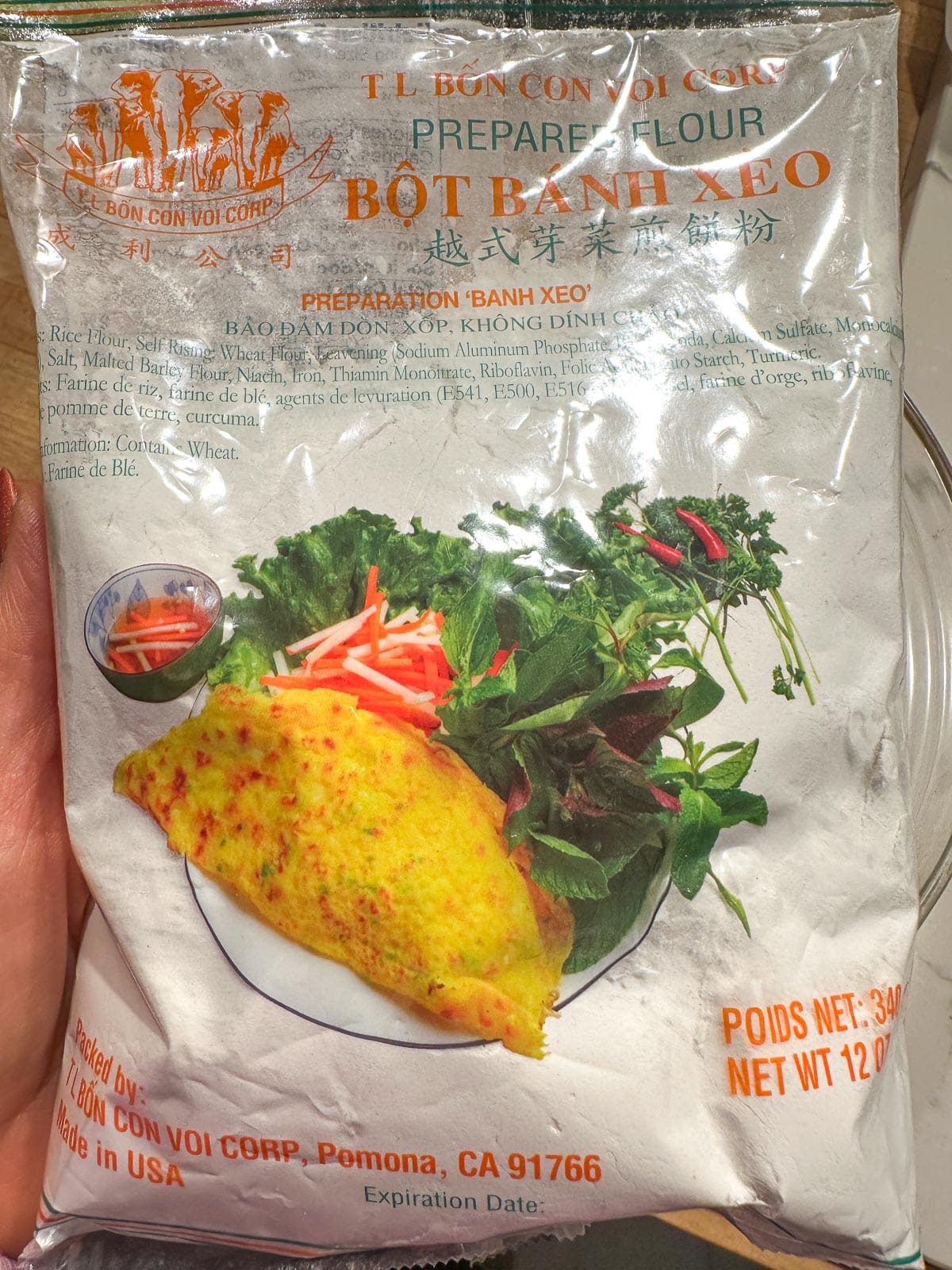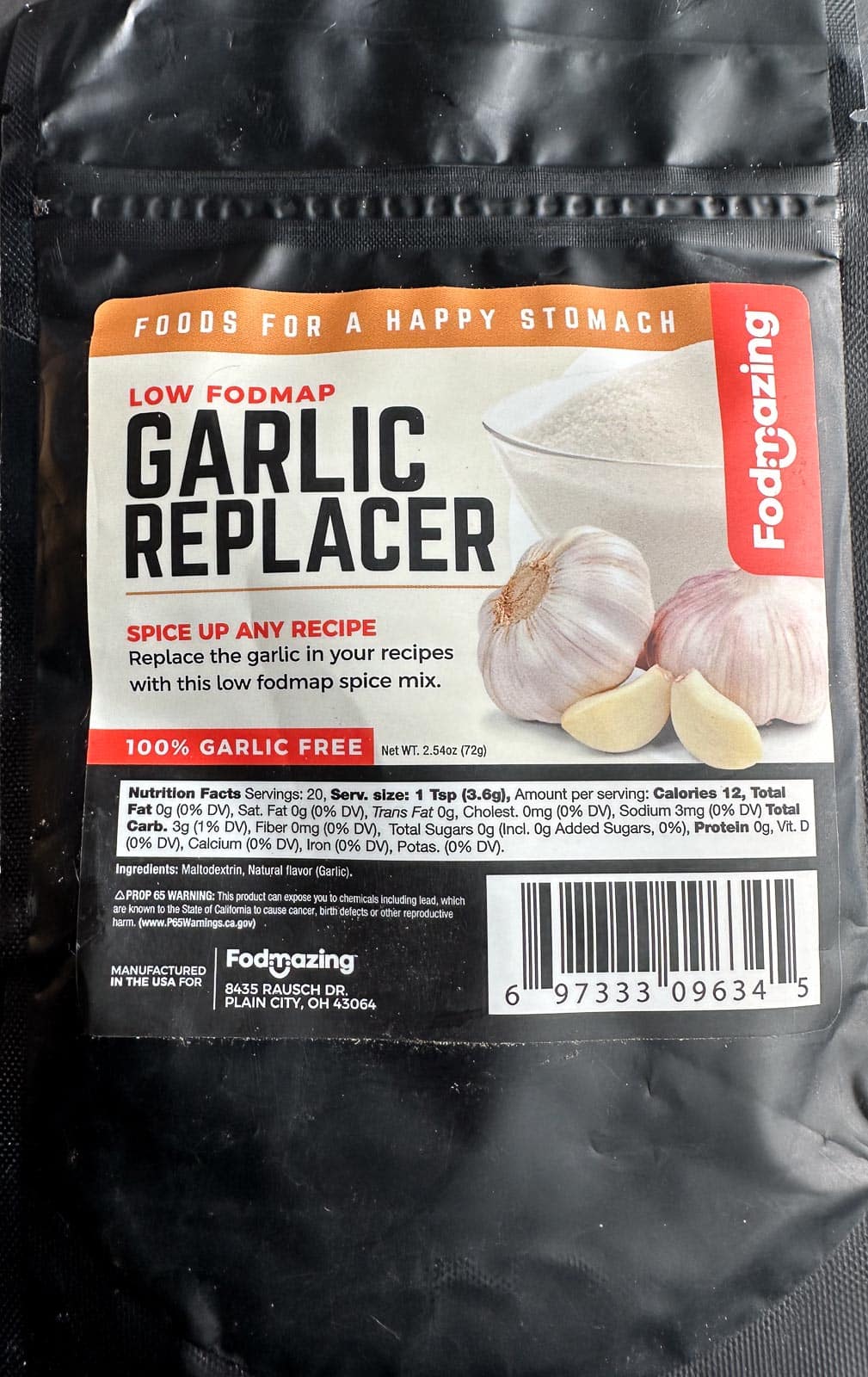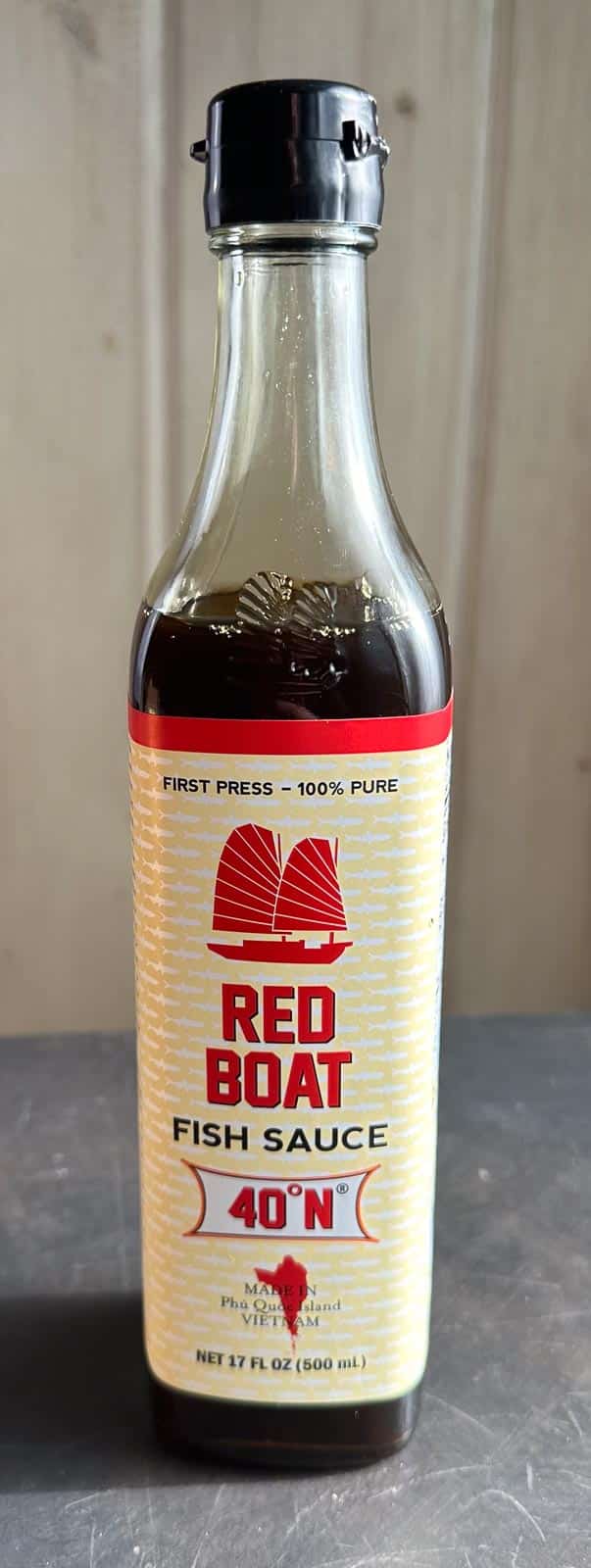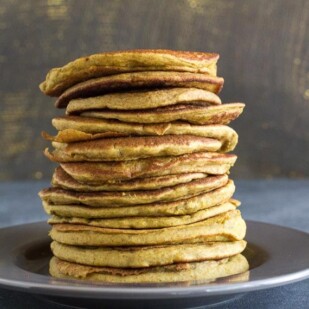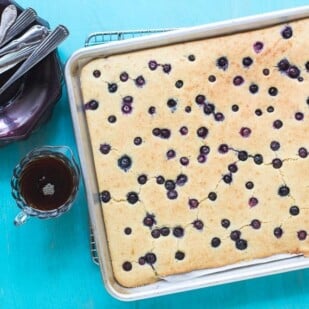Our Low FODMAP Vietnamese Pancakes, Bánh Xèo in Vietnamese, are easy to make and just as good as those you can get in a restaurant. You might know these as Sizzling Pancakes, Happy Pancakes, Vietnamese Crepes, Crispy Pancakes, or Sizzling Pancakes, among many names. And you might think they are a kind of omelet, but they are not! Their yellow color is from turmeric, and no eggs are involved. Ours have a pork and shrimp filling (our favorite), but we give you vegetable options, a well.
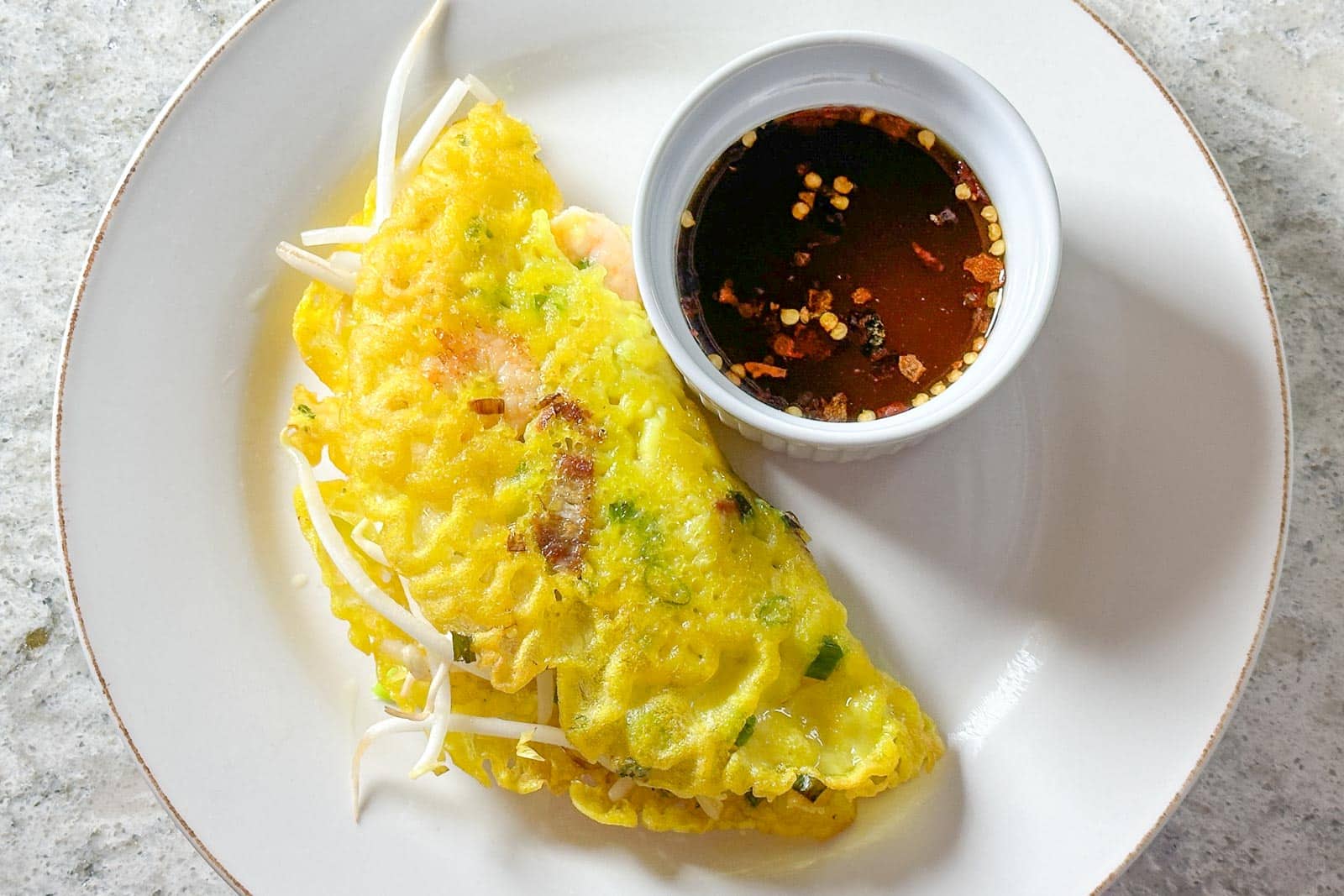
How Delicious Are These Pancakes?
OH MY! That is what my husband exclaimed as he bit into the first one. He was pleasantly stunned. Like I said, these look like an egg omelet, and you see some bean sprouts poking out. That could be perfectly delicious, but it in no way prepares you for the explosion of flavor and texture in these Vietnamese Pancakes, which are a famous and beloved dish.
What Is a Vietnamese Pancake?
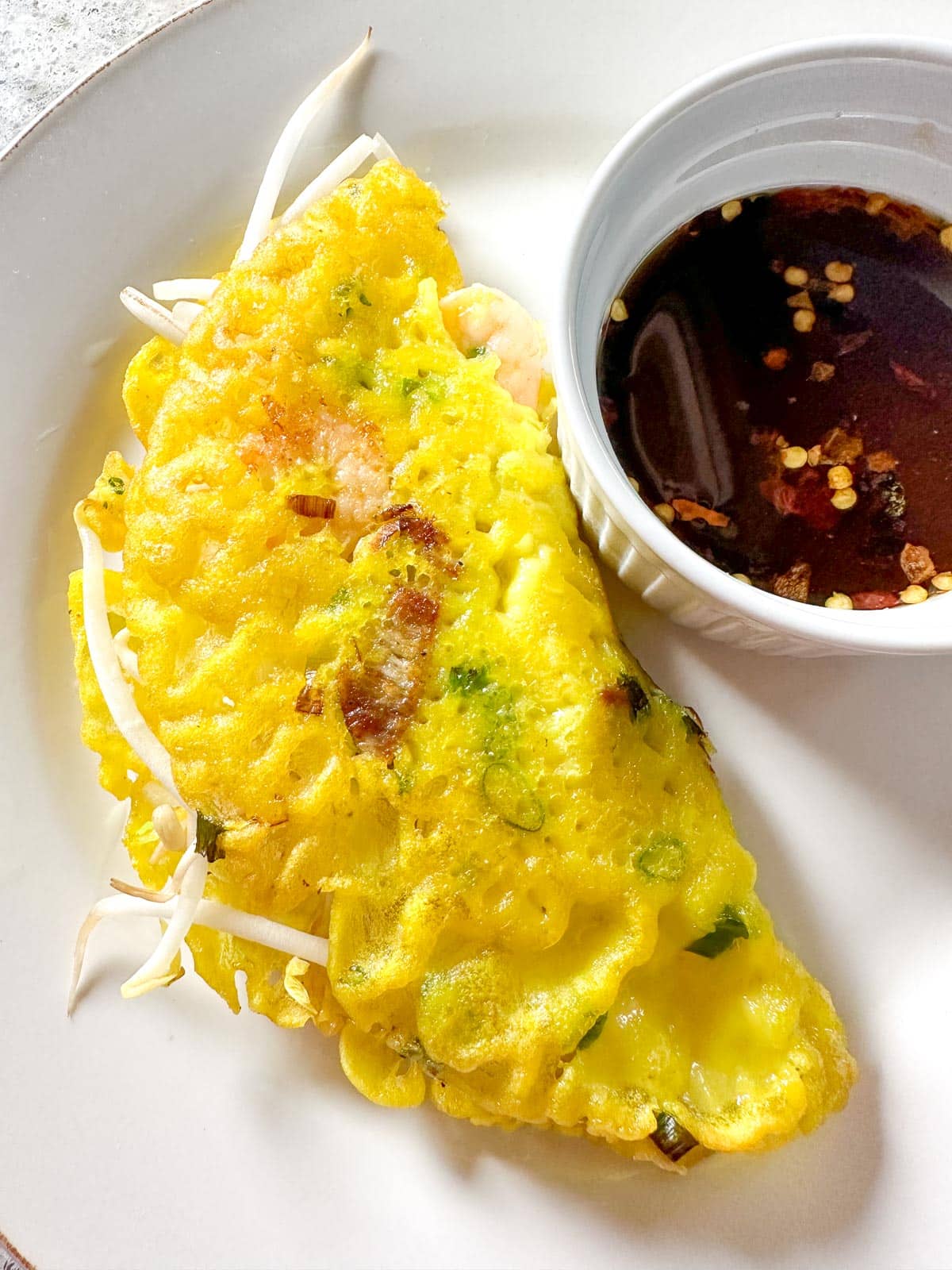
The Vietnamese pancake starts with pancake batter, made from rice flour, turmeric, and water. That’s it. Some versions add coconut milk, but I prefer the simpler version, which I have presented here.
You have to have mung bean sprouts as part of the filling, and you could leave it at that, but we love adding bits of shrimp and pork.
The pancake is served with Nuoc Cham dipping sauce, which is salty, sour and tangy and is the perfect addition to the pancake – and not optional.
The experience is one of texture, flavor and temperature contrast. The bottom of the pancake should be a bit crispy, with the rest tender. The stir-fried components should be warmed through and in contrast to the cool, crunchy bean sprouts. The sauce, served alongside, is salty and packed with umami. (I am drooling just typing this).
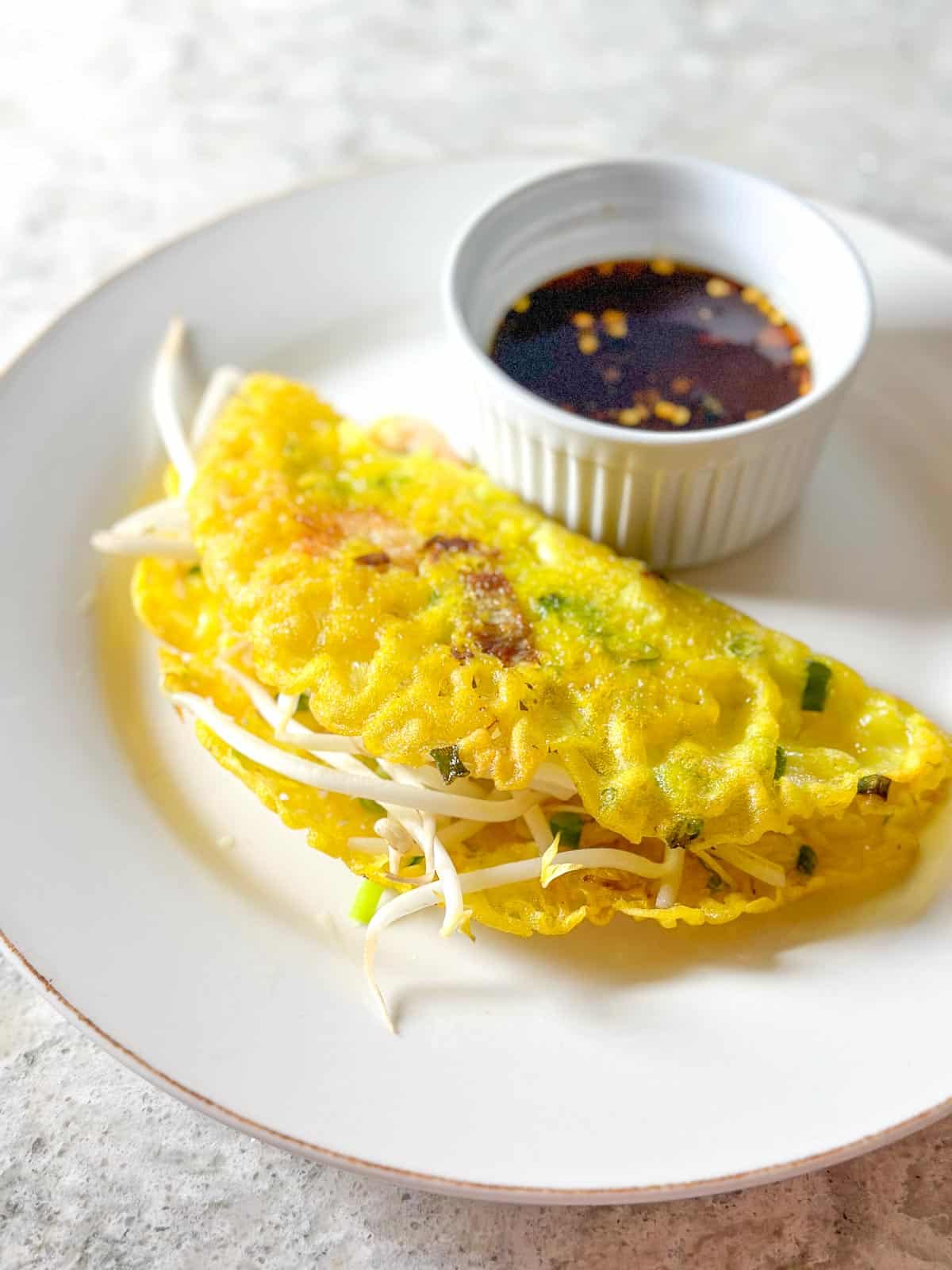
Serving and Eating a Vietnamese Pancake?
If you go to a Vietnamese restaurant, these pancakes will often be offered as an appetizer. You can certainly serve them that way, or we love to eat a couple of them as the main event. As always, eat to your tolerances.
Frequently Asked Questions
Yes, rice flour has been lab tested for FODMAPs and has a very generous serving size of 100 g, according to Monash University.
I prefer to use a specialty product which is a blend of rice flour, wheat flour, leavening agents, salt, and potato starch. You can see it and order it HERE (I find it in my local Asian supermarket). Of course, this means that the resulting dish is not gluten-free or wheat free, but the low FODMAP diet is not either. You can make the pancake with pure rice flour or the blend, but I highly recommend the blend.
If you study the Monash University app, and you should, you will see that white sandwich bread made from wheat flour is low FODMAP in 35 g portions. This recipe calls for 298 g of the flour blend, the the majority of which is rice flour. If you stick to our serving size suggestions, this recipe is low FODMAP.
Conventional garlic powder is made from dried and granulated, or powdered, garlic cloves and is considered high FODMAP. There are a couple of low FODMAP garlic powders on the market: FreeFod Garlic Replacer and Fodmazing Garlic Substitute Replacer. The FreeFod has been lab tested and is certified low FODMAP by FODMAP Friendly. Both brands contain the same ingredients – maltodextrin and natural garlic flavor. We find them to be excellent additions to your herb and spice collection. Use them as you would conventional garlic powder.
Not all fish sauce is created equal. Similar to soy sauce, lesser versions can be quite harsh, overly salty and can ruin a dish. Please try to find and use the Red Boat brand that we recommend, which is exceptional.
Just as with classic American pancakes, sometimes the first one is a dud. Don’t worry and move on. Also, having two skillets going at once will get multiple pancakes to the table more quickly.
And my two most important tips: you want a thin, even layer of oil in the pan, and the pan should be hot. You also need a lid for your skillet. The high heat and lid will get the pancake cooked crisp on the bottom, set the top, and heat your fillings all at once and together.
You can use any kind of well-seasoned or non-stick skillet, but I prefer using non-stick. If you have two skillets going at once, you can get more pancakes to the table swiftly. I use a skillet that is 10-inches (25 cm) across the top (outer edge to outer edge) with the surface that the pancake is actually cooking on about 7 to 8-inches (17 to 20 cm) across. You need tight fitting lids for the pans, too.
They can. The key would be to find a suitable low FODMAP fish sauce and I have not found one yet that I love. If you do have one, you can simply make the sauce with that and in lieu of shrimp and pork, you could stir-fry tofu or low FODMAP vegetables. Make sure to still use the mung bean sprouts as they are key to the dish!
Making Vietnamese Pancakes
Make the Nuoc Cham: Combine the vinegar and chile and heat gently, either stove top or in a microwave safe bowl in microwave that is large enough to hold all the ingredients. Here is a look at the chile:
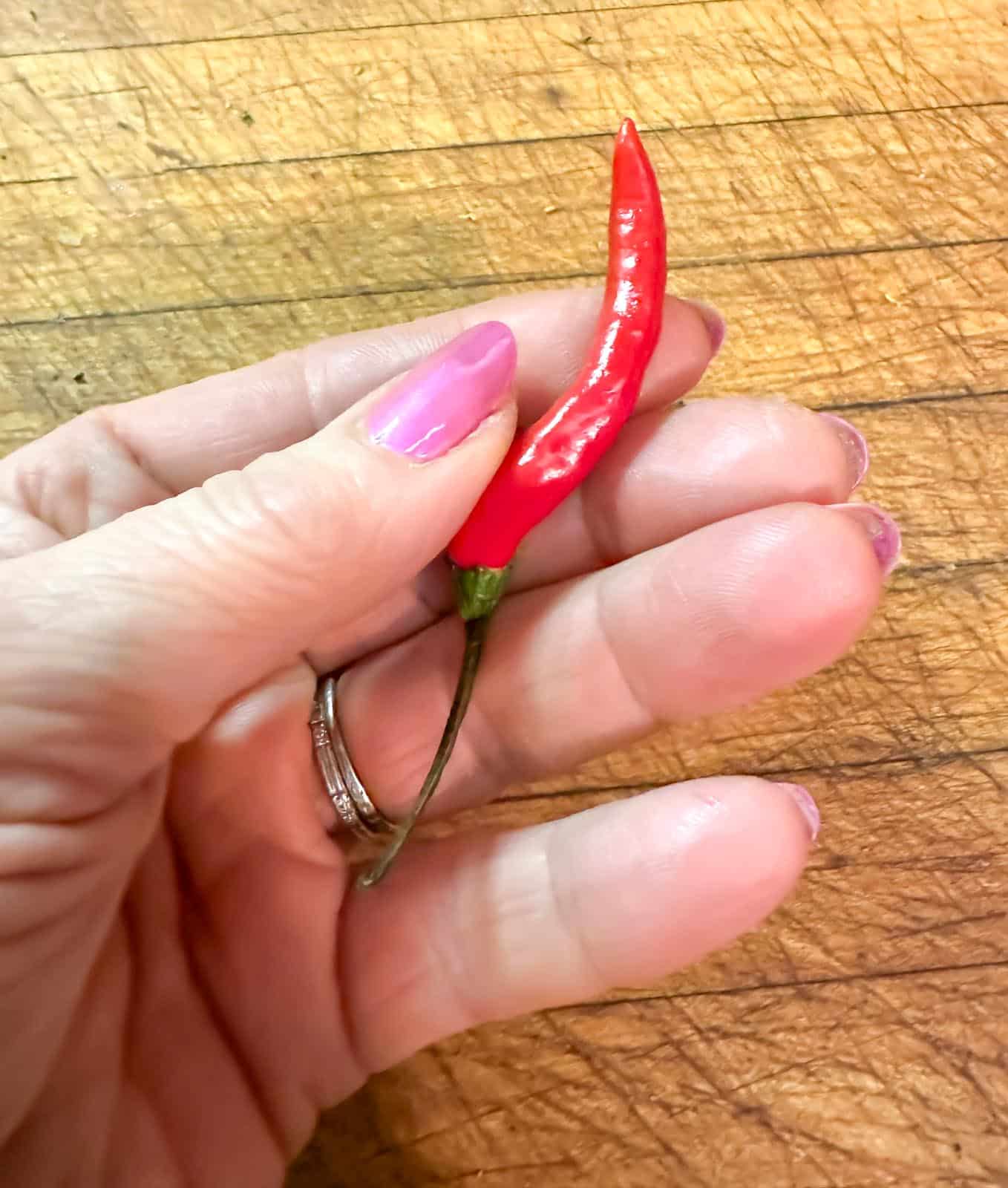
All to sit for a couple of minutes. Whisk in warm water and sugar until sugar dissolves, then whisk in fish sauce, lime juice and low FODMAP garlic powder. Set aside. This may be done up to 3 days ahead and stored in an airtight container at room temperature.
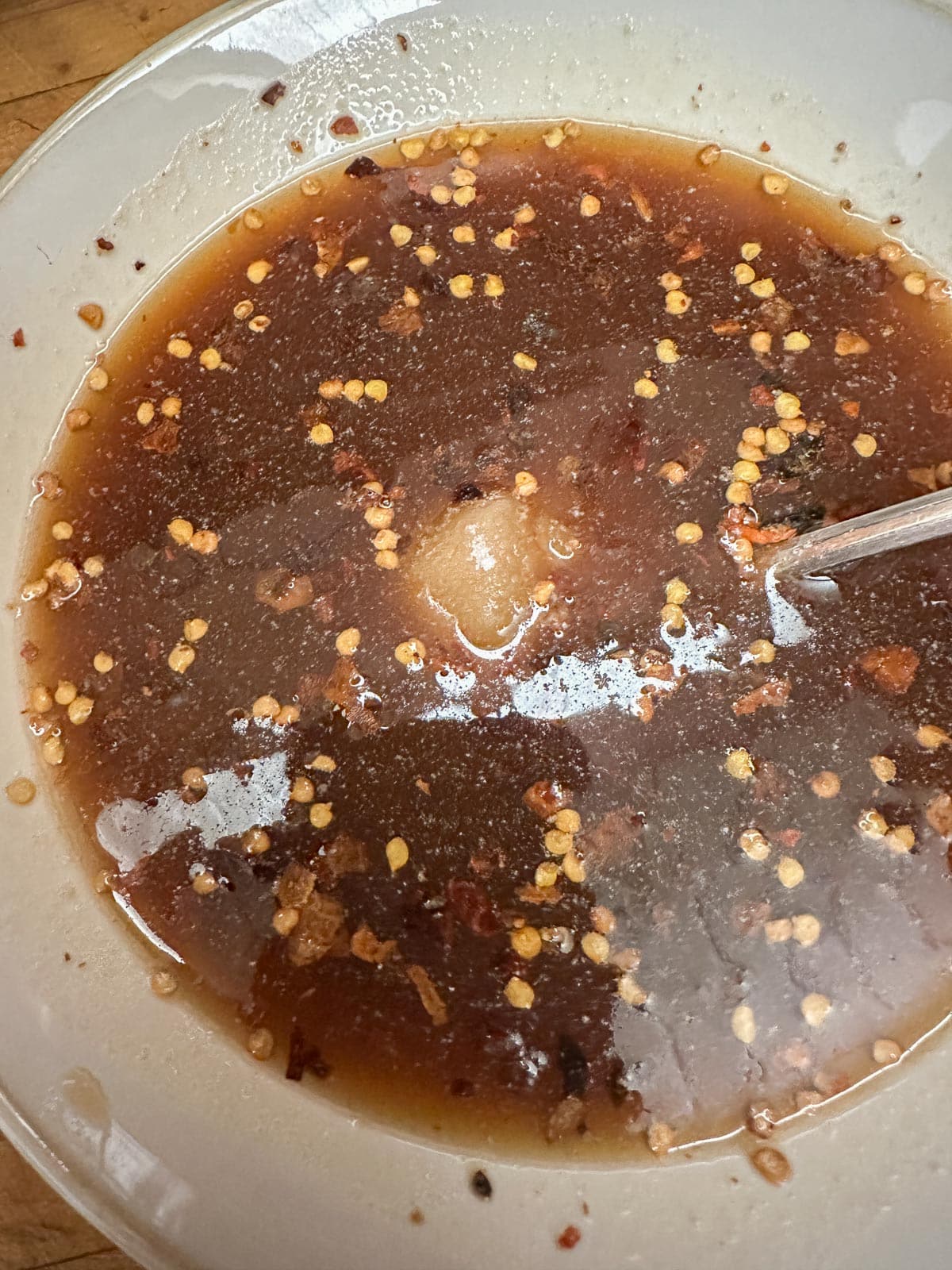
Make the Pancake: Place rice flour in a large mixing bowl and whisk in turmeric. Whisk in water until combined; the batter will be thin.
Heat pan over medium heat and add a thin layer of oil. Add about a quarter of the scallion greens, leek bulb, shrimp and pork, season with salt and pepper, and stir-fry until shrimp and pork are cooked through.
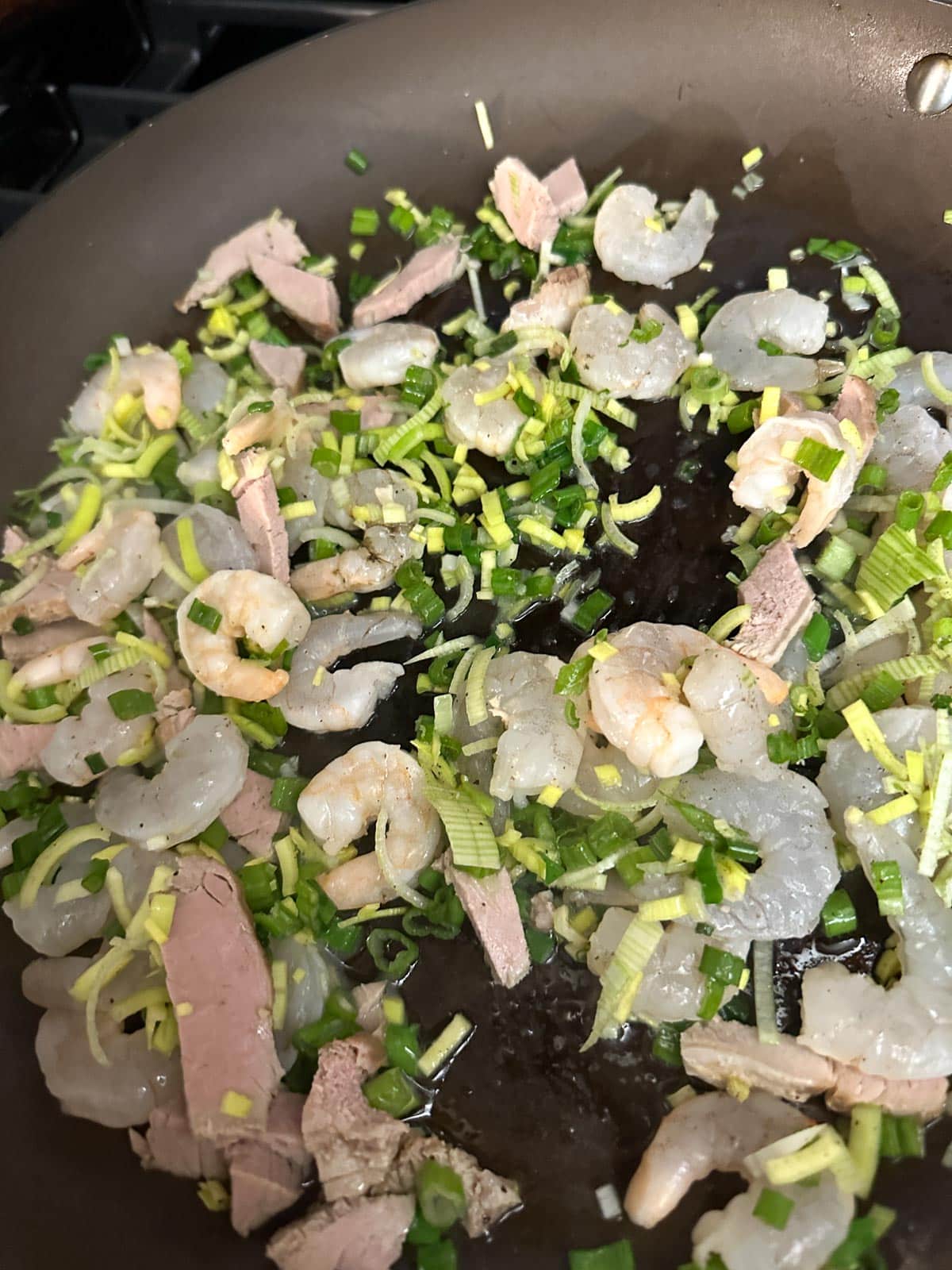
Set aside, keeping warm, and repeat with remaining scallions, shrimp and pork.
Wipe out pan with paper towel. Heat pan over high heat and add a thin layer of oil. Pour in pancake batter (it will be about ⅓ cup (75 ml)) and tilt pan as needed to thinly coat entire bottom of pan. Allow batter to cook for a few seconds to begin to set bottom, then sprinkle some of the shrimp and pork filling over half of the pancake, then immediately cover the pan.
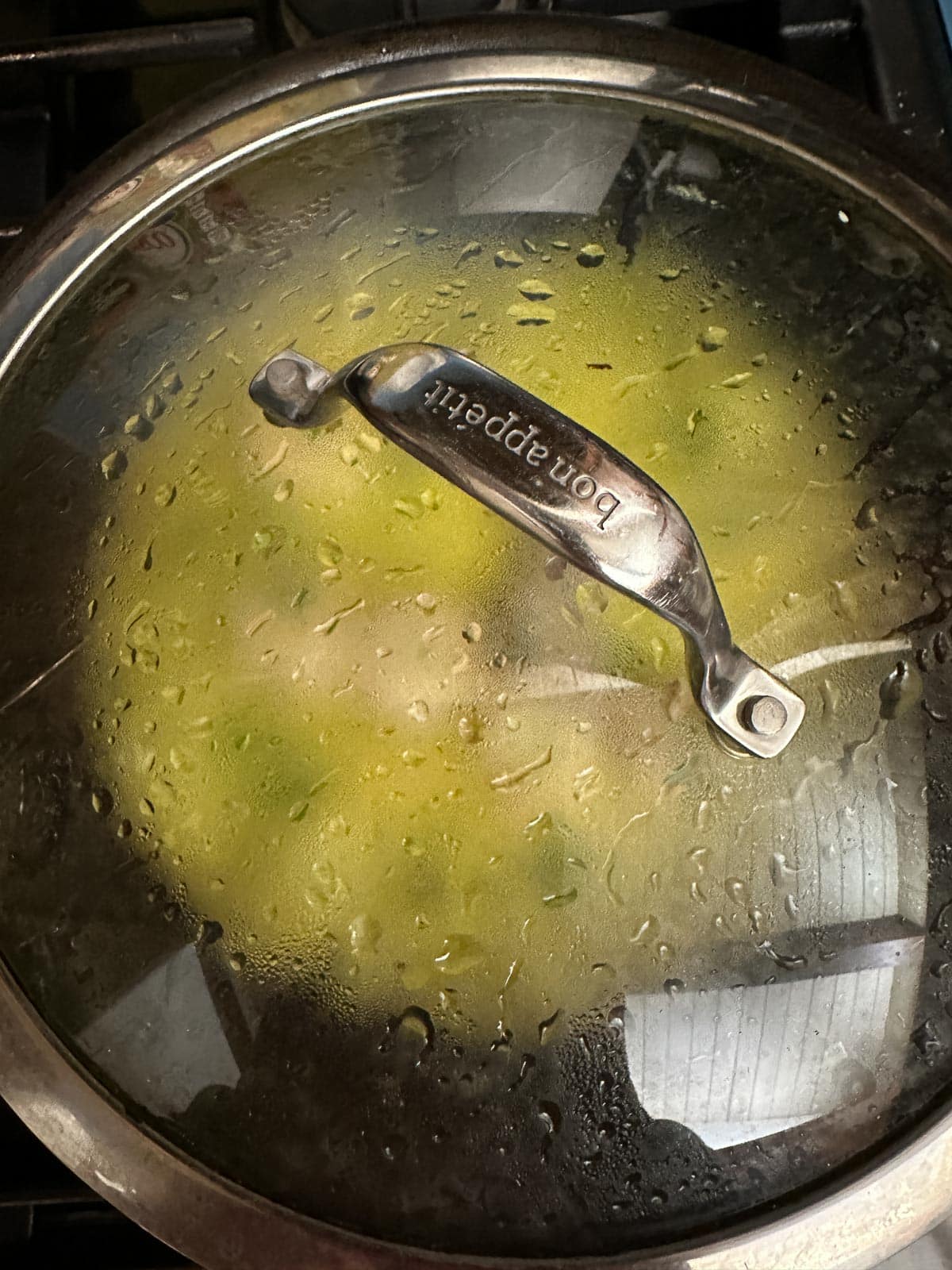
Cook until the edges of the pancake are golden brown and looking crispy you can lift the edge of the pancake to see if the bottom is crispy as well. You should hear it sizzling!
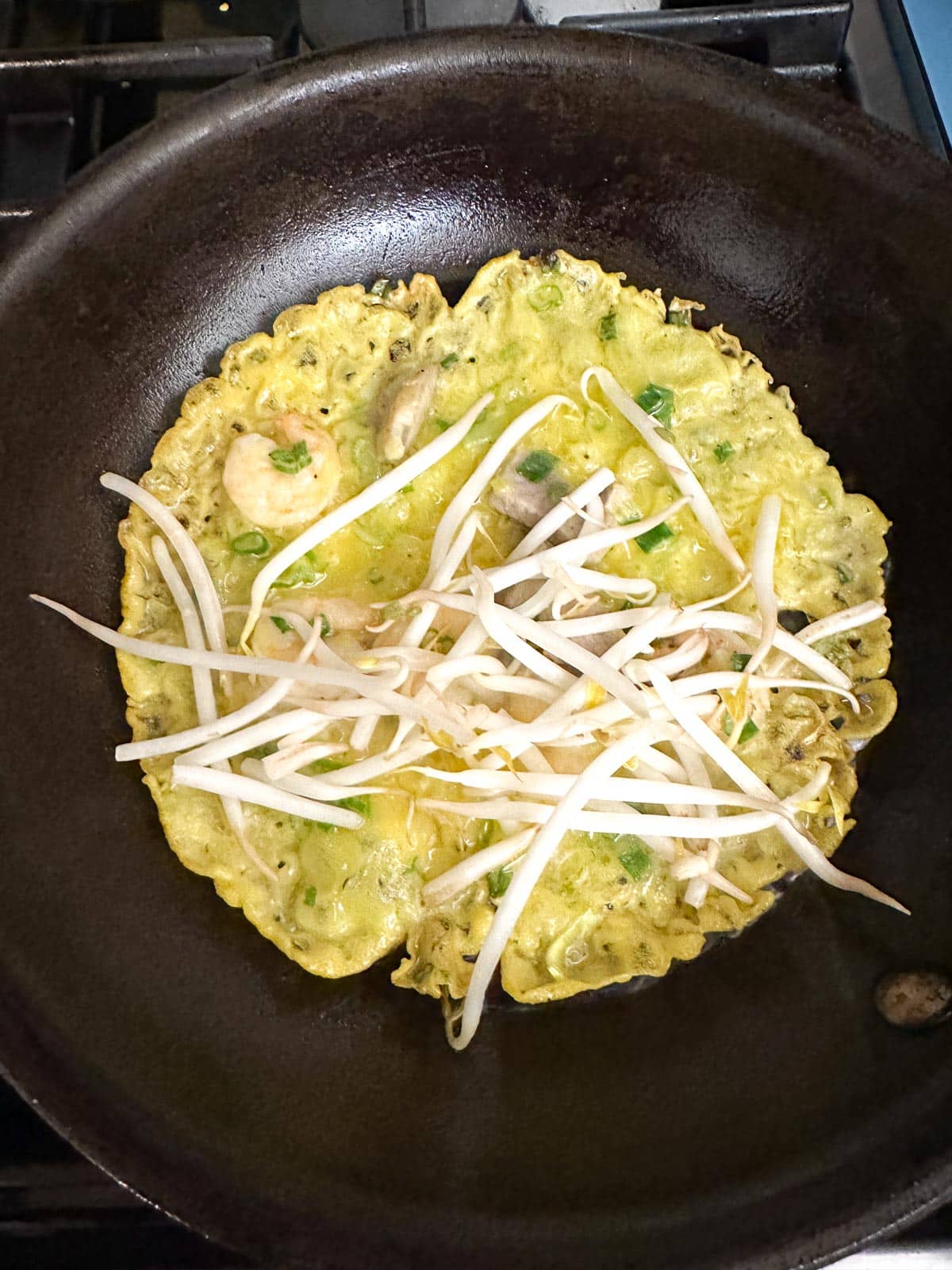
This will only take a few minutes and often is even less than that. Immediately sprinkle a generous amount of bean sprouts on top of the shrimp and pork mixture, then fold the other half of the pancake over the filling.
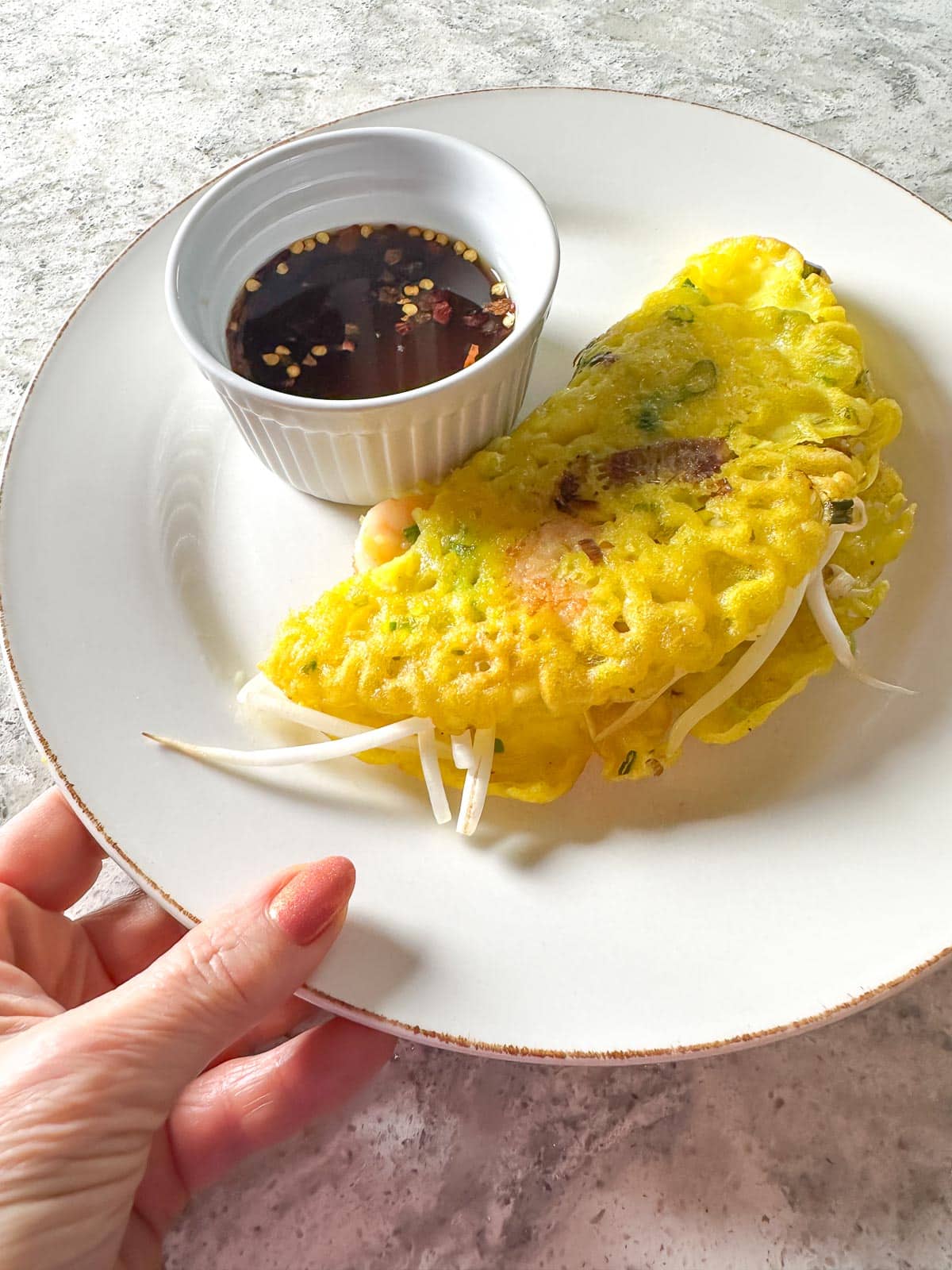
Serve immediately with the nuoc cham in a bowl alongside. Encourage people to drizzle the sauce on the pancake and they are best eaten as quickly as possible.
Repeat with remaining batter and filling. This is a production affair where you will be cooking and people will be eating, and you will be cooking, and people will be eating. You could try to keep the pancakes warm in the oven, but I think they suffer.
FODMAP Information
All recipes are based upon Monash University & FODMAP Friendly science at time of initial publication.
- Garlic-Infused Oil: Make your own Garlic-Infused Oil or buy a commercial equivalent for the easiest way to add garlic flavor to your food. Fructans in garlic are not oil-soluble, so garlic-infused oil is low FODMAP.
- Low FODMAP Garlic Powder: Conventional garlic powder is made from dried and granulated, or powdered, garlic cloves and is considered high FODMAP. There are a couple of low FODMAP garlic powders on the market: FreeFod Garlic Replacer and Fodmazing Garlic Substitute Replacer. The FreeFod has been lab tested and is certified low FODMAP by FODMAP Friendly. Both brands contain the same ingredients – maltodextrin and natural garlic flavor. We find them to be excellent additions to your herb and spice collection. Use them as you would conventional garlic powder.
- Scallions: Monash University lab testing found no FODMAPs detected in scallion greens; they suggest a 75 g serving size. FODMAP Friendly has also lab tested scallions: their recommended serving size for the green parts is 16 g, with a max low FODMAP serving of 161 g. They have also tested the bulb and it is low FODMAP in 19 g portions, which is about 2 tablespoons finely chopped.
- Sugar: Monash University and FODMAP Friendly have both lab tested white, granulated sugar. Monash states that a Green Light low FODMAP serving size of white sugar is ¼ cup (50 g). FODMAP Friendly simply states that they have tested 1 tablespoon and that it is low FODMAP. Regular granulated white sugar is sucrose, which is a disaccharide made up of equal parts glucose and fructose. Sucrose is broken down and absorbed efficiently in the small intestine. As the fructose is never in excess of the glucose, white sugar will never be high FODMAP, even in large amounts.
- Wheat Flour: The low FODMAP diet is neither wheat-free nor gluten-free. Small amounts of wheat are low FODMAP. For instance, 35 g of wheat bread made with white wheat flour – about 1 slice – has been lab tested by Monash University and is deemed low FODMAP.
Please always refer to the Monash University & FODMAP Friendly smartphone apps for the most up-to-date lab tested information. Foods will be retested from time to time; in the case of raw ingredients, such as fruits and vegetables, results may vary. All lab tested results are valid and represent a snapshot in time. As always, your tolerance is what counts; please eat accordingly. The ultimate goal of the low FODMAP diet is to eat as broadly as possible, without triggering symptoms, for the healthiest microbiome.
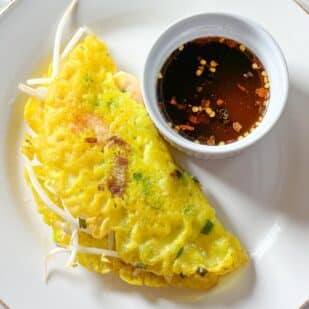
Low FODMAP Vietnamese Pancakes – Bánh Xèo
Our Low FODMAP Vietnamese Pancakes, Bánh Xèo in Vietnamese, are easy to make and just as good as those you can get in a restaurant. You might know these as Sizzling Pancakes, Happy Pancakes, Vietnamese Crepes, Crispy Pancakes, or Sizzling Pancakes, among many names. And you might think they are a kind of omelet, but they are not! Their yellow color is from turmeric, and no eggs are involved. Ours have a pork and shrimp filling (our favorite), but we give you vegetable options, a well.
Low FODMAP Serving Size Info: Makes 8 Pancakes; 8 servings; 1 pancake per serving
Ingredients:
Nuoc Cham:
- 1 tablespoon white vinegar
- 1 small hot red chile pepper, seeded and minced, or 1 teaspoon dried red chile flakes
- 1 cup (240 ml) warm water
- ½ cup (99 g) sugar
- ½ cup (120 ml) fish sauce, such as Red Boat brand (highly recommended)
- ¼ cup (60 ml) freshly squeezed lime juice
- 1 teaspoon low FODMAP garlic powder, such as FreeFod or Fodmazing
Vietnamese Pancake:
- 1 ¾ cup (298 g) prepared Bánh Xèo pancake flour (preferred), or rice flour
- ¼ teaspoon turmeric
- 2 cups (480 ml) water, at room temperature
- Vegetable oil or Low FODMAP Garlic-Infused Oil, homemade or purchased, made with vegetable oil
- ½ cup (32 g) finely chopped scallions, green parts only
- ¼ cup (15 g) finely chopped leek bulb
- 1- pound (455 g) lean pork, such as pork loin, cut into ¼-inch (6 mm) dice
- 1- pound (455 g) small or medium deveined, shell-off shrimp
- Kosher salt
- Freshly ground black pepper
- 3 cups (270 g) mung bean sprouts
Preparation:
-
Make the Nuoc Cham: Combine the vinegar and chile and heat gently, either stove top or in a microwave safe bowl in microwave that is large enough to hold all the ingredients. All to sit for a couple of minutes. Whisk in warm water and sugar until sugar dissolves, then whisk in fish sauce, lime juice and low FODMAP garlic powder. Set aside. This may be done up to 3 days ahead and stored in an airtight container at room temperature.
-
Make the Pancake: Place rice flour in a large mixing bowl and whisk in turmeric. Whisk in water until combined; the batter will be thin.
-
Heat pan over medium heat and add a thin layer of oil. Add about a quarter of the scallion greens, leek bulb, shrimp and pork, season with salt and pepper, and stir-fry until shrimp and pork are cooked through. Set aside, keeping warm, and repeat with remaining scallions, shrimp and pork.
-
Wipe out pan with paper towel. Heat pan over high heat and add a thin layer of oil. Pour in pancake batter (it will be about ⅓ cup (75 ml)) and tilt pan as needed to thinly coat entire bottom of pan. Allow batter to cook for a few seconds to begin to set bottom, then sprinkle some of the shrimp and pork filling over half of the pancake, then immediately cover the pan. Cook until the edges of the pancake are golden brown and looking crispy you can lift the edge of the pancake to see if the bottom is crispy as well. You should hear it sizzling! This will only take a few minutes and often is even less than that. Immediately sprinkle a generous amount of bean sprouts on top of the shrimp and pork mixture, then fold the other half of the pancake over the filling. Serve immediately with the nuoc cham in a bowl alongside. Encourage people to drizzle the sauce on the pancake and they are best eaten as quickly as possible.
-
Repeat with remaining batter and filling. This is a production affair where you will be cooking and people will be eating, and you will be cooking, and people will be eating. You could try to keep the pancakes warm in the oven, but I think they suffer.
Notes:
FODMAP Information
All recipes are based upon Monash University & FODMAP Friendly science at time of initial publication.
• Garlic-Infused Oil: Make your own Garlic-Infused Oil or buy a commercial equivalent for the easiest way to add garlic flavor to your food. Fructans in garlic are not oil-soluble, so garlic-infused oil is low FODMAP.
• Leeks: Both Monash University and FODMAP Friendly have lab tested leeks – greens (leaves) and bulbs. Monash University recommends a low FODMAP serving size of 100 g for the greens, and 14 g for the bulb. FODMAP Friendly suggests a serving size of leek greens of 37 g, with a low FODMAP max serve of 83 g. Their recommended low FODMAP leek bulb amount is 46 g.
• Low FODMAP Garlic Powder: Conventional garlic powder is made from dried and granulated, or powdered, garlic cloves and is considered high FODMAP. There are a couple of low FODMAP garlic powders on the market: FreeFod Garlic Replacer and Fodmazing Garlic Substitute Replacer. The FreeFod has been lab tested and is certified low FODMAP by FODMAP Friendly. Both brands contain the same ingredients – maltodextrin and natural garlic flavor. We find them to be excellent additions to your herb and spice collection. Use them as you would conventional garlic powder.
• Scallions: Monash University lab testing found no FODMAPs detected in scallion greens; they suggest a 75 g serving size. FODMAP Friendly has also lab tested scallions: their recommended serving size for the green parts is 16 g, with a max low FODMAP serving of 161 g. They have also tested the bulb and it is low FODMAP in 19 g portions, which is about 2 tablespoons finely chopped.
• Sugar: Monash University and FODMAP Friendly have both lab tested white, granulated sugar. Monash states that a Green Light low FODMAP serving size of white sugar is ¼ cup (50 g). FODMAP Friendly simply states that they have tested 1 tablespoon and that it is low FODMAP. Regular granulated white sugar is sucrose, which is a disaccharide made up of equal parts glucose and fructose. Sucrose is broken down and absorbed efficiently in the small intestine. As the fructose is never in excess of the glucose, white sugar will never be high FODMAP, even in large amounts.
• Wheat Flour: The low FODMAP diet is neither wheat-free nor gluten-free. Small amounts of wheat are low FODMAP. For instance, 35 g of wheat bread made with white wheat flour – about 1 slice – has been lab tested by Monash University and is deemed low FODMAP.
Please always refer to the Monash University & FODMAP Friendly smartphone apps for the most up-to-date lab tested information. Foods will be retested from time to time; in the case of raw ingredients, such as fruits and vegetables, results may vary. All lab tested results are valid and represent a snapshot in time. As always, your tolerance is what counts; please eat accordingly. The ultimate goal of the low FODMAP diet is to eat as broadly as possible, without triggering symptoms, for the healthiest microbiome.
Nutrition
All nutritional information is based on third-party calculations and should be considered estimates. Actual nutritional content will vary with brands used, measuring methods, portion sizes and more. For a more detailed explanation, please read our article Understanding The Nutrition Panel Within Our Recipes.
